List of Authors
>>About this blog
Recent blog post
|
[kimitaku]
March 28, 2013 15:44
To commemorate the opening of the Shin Kabukiza Theater, a parade "Ginza Hanamichi" was held on the morning of the 27th at Ginza Chuo-dori, Chuo-ku, by 60 young Kabuki actors, including Tokizo Nakamura and Ebizo Ichikawa.
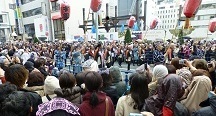 At the event, entitled "Century's Training," 32,000 Kabuki fans gathered and cheered in the windy light rain. At the event, entitled "Century's Training," 32,000 Kabuki fans gathered and cheered in the windy light rain.
From Ginza 1-chome to just before Matsuya, if the weather was fine, the parade started at 10:00 and ended at 11:00, with the wind fluttered and the departure was greatly delayed in the light rain, and started after 10:30. The security police officers ask the audience to take the lead and fold their umbrellas. Everyone knocked on the umbrella, everyone became wet rats, and watched the start with a strong spit. The announcer was Mr. Tokumitsu.
"Done,"
With the signal of the fireworks, the procession started. At that moment, the rain fell down, and cheers came from the starting point to Mizuho Bank, which I waited for.
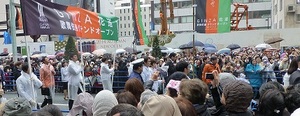
At first, the actors looked down, looked up at the heavens, walked silently, but with the rise of cheers, smiled, broken face, and saw it, the audience, a woman shed tears, The old couple raised their hands and shouted to their favorite actors.
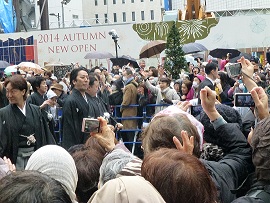 The speed of the march is very fast, and the audience from 1-chome rushed to 2-chome to chase it, 2-chome overlaps with 1-chome, 3-chome seems to overlap with 1-chome, and the sidewalk gradually became hot There was no footstep. The speed of the march is very fast, and the audience from 1-chome rushed to 2-chome to chase it, 2-chome overlaps with 1-chome, 3-chome seems to overlap with 1-chome, and the sidewalk gradually became hot There was no footstep.
 The march time ended for more than 10 minutes, but everyone who supported this parade was really happy to see and support the century's "drenting". The march time ended for more than 10 minutes, but everyone who supported this parade was really happy to see and support the century's "drenting".
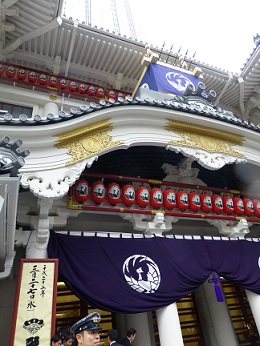 The new Kabukiza Theater also blends well into the atmosphere of Ginza while maintaining the atmosphere of the time based on plaster. The new Kabukiza Theater also blends well into the atmosphere of Ginza while maintaining the atmosphere of the time based on plaster.
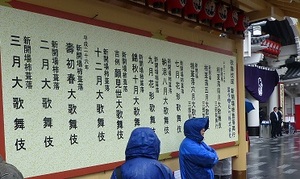 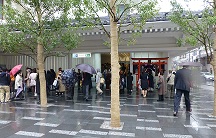
In addition, from Higashi-Ginza Station, you can enter without an umbrella even on rainy days, making it easy for customers.
The Kabuki performance will finally begin on April 2nd.
[shikichan]
March 25, 2013 14:00
Nihonbashi Takashimaya was completed on March 20, 1933 (Showa 8), and the first department store-wide air-conditioning and ventilation system was introduced.

It's been 80 years since then. In the meantime, the building was expanded in 1952, 29, 38, and 40 years, and was designated as the first national important cultural property in department stores in 2009 (21).
This is a diorama created by diorama writer Takaki Yamamoto, the building at the time of its opening. This building was designed by Sadataro Takahashi, incorporating Orient-like elements into the solid Western history style. At that time, there was a streetcar running, and there was no red tent like it is now.
At that time, this eight-story building could be seen well from a distance, so TAKASHIMAYA's illumination signboard would not have been needed.
The poet Akiko Yosano wrote, "Takashimaya Overlay the towers that add the area of the shining capital."
It seems that he claimed the hard work "ro" and the tower of the tower.
[Silver]
March 22, 2013 14:00
With the "Guide Map of Kazuo Confectionery Association in Chuo-ku", we are purchasing representative products of each shop.  At that time, a shop sells "broken rice crackers", and the bag says "Kusuke". At that time, a shop sells "broken rice crackers", and the bag says "Kusuke".
Hey, I knew that "I call a broken rice cracker called Kusuke."  Speaking of which, I remembered that I learned such a thing from Kyoba Peony. According to the dictionary, Hisa is the same pronunciation Q. → Speaking of which, I remembered that I learned such a thing from Kyoba Peony. According to the dictionary, Hisa is the same pronunciation Q. →  It means that one is not enough for the perfect 10, so it is called this, and it is said that it is an industry word mainly used in the rice crackers industry. It's stylish! It means that one is not enough for the perfect 10, so it is called this, and it is said that it is an industry word mainly used in the rice crackers industry. It's stylish!
The "Guide map of Kazuo Chuo-ku Confectionery Association", which I always bring when I go out, is very useful. There are 38 merchants, so far we have visited 20 stores, put their receipts on a map, and used them as stamp cards. It's very fun.  How would you like to join us? In addition, the guide map of the Kazuo Confectionery Association in Chuo-ku can be obtained at the stores of each member store. For more information, please refer to this guide from "NPO Chuo Net". http://www.tokyochuo.net/sightseeing/wagashi/index.html How would you like to join us? In addition, the guide map of the Kazuo Confectionery Association in Chuo-ku can be obtained at the stores of each member store. For more information, please refer to this guide from "NPO Chuo Net". http://www.tokyochuo.net/sightseeing/wagashi/index.html
[Old Counselor]
March 22, 2013 09:00
-thumb-150x320-12149.jpg)
Surrounded by six ginkgo trees in the immediate vicinity of my office
In Chuo-ku, there is Ginkgo Inari Shrine, the only shrine dedicated to Hachimangu Shrine.
I was interested, and after a little research, I was able to know the following:
History: The shrine hall was destroyed by the Great Kanto Earthquake of 1923.
It was in Ansei 4 (1775) that enshrined deity was enshrined in the shrine, covering the sky at that time.
There is a large ginkgo towering ginkgo, and its age was estimated to be 3 to 400 years.
It is thought that the shrine was built before that.
This ginkgo Inari Shrine is the only shrine dedicated to Hachimangu Shrine in Chuo-ku.
In the Meiji era, the literary writer Junichirou Tanizaki enjoyed once a month of the Kagura of Ginkgo Yahata Shrine.
I wrote it in "I'm a child."
Interest: Ginkgo Inari Shrine is a god of business prosperity from a nearby securities company in Kabuto-cho.
Thank you very much.
It is also said that there are applications for donations from companies in other prefectures.
It is also worshiped by the residents of shrine parishioner as the god of prosperity and longevity.
A woman living nearby visited every day from a young age to a hundred years old, so she was healthy and 103 years old.
There is a real story that fulfills longevity.
-thumb-130x320-12152.jpg)
<Ginkgo Inari Shrine>
1-7-7 Kakigara-cho, Chuo-ku
3-minute walk from Exit 8 in front of Suitengumae Subway Hanzomon Line
1.
March 21, 2013 14:00
The Takashimaya Nihonbashi store, which completed Nagar Skin Care at the end of last year, celebrated its 80th birthday on March 20. The effect of careful care is outstanding, and this skin is 80 years old! I'm a little enviable.


Takashimaya, founded in Kyoto, built a new store in Tokyo in 1933. It is 2 floors below ground and 8 floors above ground and is fully air-conditioned. The copy at that time, "Hot place in Tokyo, where I left Takashimaya" is famous. After that, the extension was also made by Togo Murano, and it was designated as a heavy sentence for the first time as a department store building in 2009 (2009).
Various events are scheduled from March 20 to April 2 as the 80th anniversary of the opening of the store. I missed today's `` mini-concert by Chuo-ku Joto Elementary School Children '' to decorate the opening, but on the 22nd, talk show by Somegoro Ichikawa, and on each floor, 800 yen in the name of an anniversary pack, 800 yen, 800 yen uniform bargain price The product PAK is crowded.


The left above is a miniature that reproduces the store at the time of opening. Next door is a panel of the history of the store since its opening.

You can also see Takashimaya's specialty mascot, "Rose-chan" dolls, are slightly embarrassed here and there on the floor with different kimonos.
Is this year's cherry blossoms fast? Nihonbashi Sakura-dori St. The flowers bloom for another 3 minutes.
Why don't you go to Nihonbashi to serve as a cherry blossom viewing?
[Yotaro]
March 14, 2013 09:00
 "Maruzen World fountain pen exhibition and spot sale" The other day, when I passed through Maruzen in Nihonbashi, I noticed such a guide. Maruzen was a pioneer who invited not only Western books but also Western stationery to Japan of the Restoration. Regarding the fountain pen, the encyclopedia states, "In Japan, Maruzen Co., Ltd. in Tokyo launched a small amount of waterman products at stores in 1895 (Meiji 28), and full-scale imports were in 1902 (Meiji 35). " (The whole book of Japanese University Encyclopedia (Shogakukan))). "Maruzen World fountain pen exhibition and spot sale" The other day, when I passed through Maruzen in Nihonbashi, I noticed such a guide. Maruzen was a pioneer who invited not only Western books but also Western stationery to Japan of the Restoration. Regarding the fountain pen, the encyclopedia states, "In Japan, Maruzen Co., Ltd. in Tokyo launched a small amount of waterman products at stores in 1895 (Meiji 28), and full-scale imports were in 1902 (Meiji 35). " (The whole book of Japanese University Encyclopedia (Shogakukan))).
After that, fountain pens spread rapidly, and a large number of celebrities wrote and sketches (drawn with a fountain pen) in the booklet entitled "Impressions and Illustration Catalog" issued by Maruzen in 1912 (Meiji 45). ) Etc. The beginning of the book is Soseki Natsume (1867-1916)'s "Yoto Mannen Pen".
In this sentence, Soseki says that he has just started using a fountain pen and is less familiar. Twelve years ago, when studying in the UK, a fountain pen that I received as a farewell from a relative (Mrs. Kyoko's sister Tokiko) broke down on the ship by mimicking an instrumental gymnastics (iron bar). Three or four years ago, I bought two "pelicans" in Maruzen, but I returned to the original pen writing because "I was unhappy and I was not very grateful for the remaining pelicans." He said that he felt like "I miss my separated wife later." He said, "This manuscript was written by Roan-kun (Roan Uchida (1868-1929), who was an advisor to Maruzen at the time), and was given to him to look at it, but it was very comfortable and I was able to write smoothly. " This booklet also contains a photo of the manuscript of this sentence written by Soseki in "Onoto G".
It is a sentence that has no advertising smell to put it on a fountain pen PR booklet, but when I read what Luan wrote, "Natsume-san was a person who favored me. I asked me to write about a fountain pen, but I didn't have a bad face, but said, "I'm in trouble." So, no, I just asked you to write something useful because you only have to say it bad." Also, in Soseki's discourse later published in a newspaper, "I'm using the second generation, Onoto." I don't think this is good, but I got it from Maruzen's Roan Uchida, so it's until I use it." Even though I bought the convenience, I didn't think so much. According to Luan, Soseki hated glass ink stands, and ink hated blue black and liked sepia color.
At the time of joining Soseki, the Asahi Shimbun was located in Takiyama-cho, Kyobashi-ku (now Ginza 6-chome), as is known for the song by Takuboku Ishikawa (1886-1912). Sojinkan Sugimura (1872-1945), who entered the morning sun at the invitation of his main writing Ikebe Sanzan (1864-1912), said Soseki rarely came to the office, but when he came out at an editorial meeting held on Wednesday, everyone was laughing and laughing at every moment. Did Soseki's hand at such times have Onoto's fountain pen?
Soseki also favors Onoto, who did it, dominates the world as a luxury fountain pen, but after the war, the manufacturer U.K. de la Luo stopped manufacturing fountain pens. Currently, Maruzen sells a high-end fountain pen of "reprinted version" bearing the name of Onoto. In Nihonbashi Maruzen, the fountain pen section is on the first basement floor. As I looked around the sales floor where everything from ultra-luxury items to popular items was beautifully lined up, I noticed myself, who had no connection with fountain pens for a long time, and at the same time, when I was a child more than fifty years ago, my late parents now came back to the excitement of buying a fountain pen for the first time.
|
Links
|
 At the event, entitled "Century's Training," 32,000 Kabuki fans gathered and cheered in the windy light rain.
At the event, entitled "Century's Training," 32,000 Kabuki fans gathered and cheered in the windy light rain. The speed of the march is very fast, and the audience from 1-chome rushed to 2-chome to chase it, 2-chome overlaps with 1-chome, 3-chome seems to overlap with 1-chome, and the sidewalk gradually became hot There was no footstep.
The speed of the march is very fast, and the audience from 1-chome rushed to 2-chome to chase it, 2-chome overlaps with 1-chome, 3-chome seems to overlap with 1-chome, and the sidewalk gradually became hot There was no footstep. The march time ended for more than 10 minutes, but everyone who supported this parade was really happy to see and support the century's "drenting".
The march time ended for more than 10 minutes, but everyone who supported this parade was really happy to see and support the century's "drenting". The new Kabukiza Theater also blends well into the atmosphere of Ginza while maintaining the atmosphere of the time based on plaster.
The new Kabukiza Theater also blends well into the atmosphere of Ginza while maintaining the atmosphere of the time based on plaster.



-thumb-150x320-12149.jpg)
-thumb-130x320-12152.jpg)

